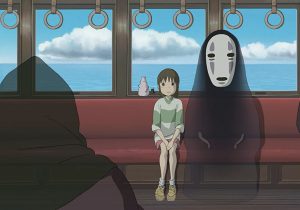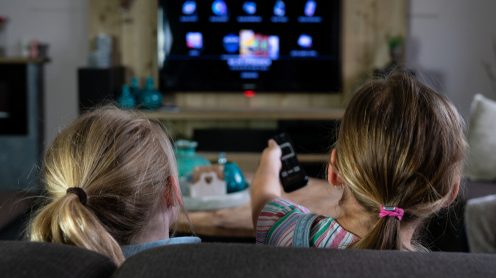The idea of a family movie night involves a host of fun rituals: popping the popcorn, gathering blankets and pillows in the living room, and dimming the lights to create the perfect movie theater setting.
But for many families, the most important step is often the hardest one: finding the right movie.
“Friday movie nights can be challenging!” said Melissa Brady, a mom of seven from Los Angeles County. “We have such a wide range of ages and tastes that sometimes we find ourselves searching for what to watch so long that all the popcorn and candy is gone before the movie even starts.”
But more and more, the domestic dilemma is becoming more than just a simple matter of differing tastes.
LA-area mom Emily Goodwin has six children, ages 1 through 12. For her, the bigger challenge is finding a film her brood will enjoy without being scandalized. During one recent family movie night, a scene in the film made reference to men not being faithful to their wives.
“My littlest kids, of course, had no idea what they were talking about, but we did have to talk about it with the big kids,” recalled Goodwin.
And as Brady pointed out, infidelity is just one in a growing list of troubling themes working their way into popular kids’ media.
“There are many shows now which portray gender confusion as normal,” she noted. When it comes to animated films, an entire Wikipedia page demonstrates the increasing popularity of this trend, which clashes with many families’ moral beliefs.

Goodwin’s and Brady’s experiences are hardly isolated ones. For many parents, finding a “good” family film is like finding a needle in a haystack.
“I often find that the whole show is wonderful,” said Megan Harrington, a senior producer at LA-based Family Theater Productions, “and then there’s that one moment that I feel I don’t want my nieces and nephews [seeing that], or I don’t feel comfortable watching that with my mom.”
Amid the constant battle of managing media at home, the question arises: Is family movie night even worth it?
Longtime Catholic movie critic Steven D. Greydanus describes two options for parents. “You can either opt out of popular culture entirely, or you can try to make the best choices that you can and have conversations with your children about the elements in these … movies, with the understanding that they’re going to be encountering the same mindset and the same worldview in life.”
Both options present challenges. And as more parents feel that good family films are increasingly hard to find, Greydanus and others in the film industry face the challenge of convincing them not to pull the plug — and to see family movie night as both possible and worthwhile.
“The opposite of the golden age”
Looking back on his own experience raising children, Greydanus described the movie backdrop of his children’s upbringing as a “golden age,” studded with the early Pixar films, which spurred other studios like DreamWorks to produce other great films. But since then, things seem to have gone downhill.
“Over the past decade or so, Pixar has declined markedly in quality, and the other studios. … It’s been the opposite of that golden age,” he said. “Hollywood animation in general has collapsed creatively.”
Part of the problem, he continued, is the dominance of the Walt Disney Company over much of the industry. Now the owner of Pixar Animation Studios, 20th Century Studios, Lucasfilm Studios, and Marvel Studios, Disney has shrunk the space for creative competition, according to Greydanus. “Disney is the mouse that swallowed Hollywood,” he said.

Another explanation for the decline in family-film quality is that the term “family film” is so hard to define. Father David Guffey, CSC, national director of Family Theater Productions, has found that besides the diversity among family cultures and backgrounds, few families watch films all together.
“When you say ‘family content,’ you really have to ask what people mean by that,” he told Angelus. “I’ve had people tell me that a hard PG-13 movie was family [content]. And I think, ‘Well, not if your family has got 5- and 6-year-olds in it!’ It really depends on your perspective.”
Because of its vagueness, said Father Guffey, the term “family film” can become a catchall marketing label for studios to draw a bigger audience, even if it ends up offending some.
Father Guffey and his filmmaking colleagues tend to direct their projects toward more specific groups within families: small kids, teenagers, moms, or dads. And in many ways, that fracturing of the family film category makes sense. Different age groups and maturity levels will find different content appealing.
At the same time, Hollywood provides precious few options that would even be appropriate, let alone enjoyable, for the whole family. Most studios have all but abandoned G-rated, “general audience” films, and even PG movies are falling to the wayside in favor of edgier PG-13 content. A recent Wall Street Journal article reported that between 2010 and 2019, PG-13 movies grossed more than twice as much as PG movies, at $54.6 billion.
While the trend might appeal to older audiences and yield studios a higher profit (after all, most children don’t pay for their own movie tickets or streaming subscriptions), it also narrows the range of choices for a stress-free family movie night.
Even for parents who don’t mind moments of adult language or violence, they still have something to be wary of in even the most apparently kid-friendly films: confusing messages about sexuality and marriage.
“There's no question that the world in which we live — and this is not just entertainment — is increasingly out of step with traditional Christian and Catholic sexual morality,” said Greydanus, “and that situation is only going to become more pronounced in the years ahead.”

It’s not difficult to find examples. The recent Netflix hit “The Mitchells vs. the Machines,” an animated family adventure film, includes a post-credit sequence in which one protagonist and her mother mention her new girlfriend. The brief, easy-to-miss moment did not prevent Greydanus from giving the film a glowing review, but he noted that this theme will only grow more prevalent.
Disney, and the people catering to the same audience as Disney, are looking to make waves,” he said. “They’re looking to feel good about being socially progressive and socially responsible from their point of view. They want to go home at the end of the day and feel like they’ve made a positive difference in the world. And to them, this is the way of doing that.”
Greydanus disagrees with the “culture warrior” approach, namely signing petitions, boycotting films, or canceling streaming subscriptions to protest this film trend. “I don't think that we’re going to win hearts and minds that way, and I don't think we’re going to win the culture that way.”
But to keep family movie night alive without losing control of what images and ideas enter the living-room screen, parents face no small task: navigating the minefield of the industry.
“Custody of hearts and minds”
While the Goodwins generally limit screen time when it comes to choosing a family movie, intentionality is key. “When we do watch movies or shows, we put thought into what we’re putting on for them,” said Goodwin. “One of our biggest criteria is, ‘Has it stood the test of time?’ ”
But Goodwin and her husband also take other measures, like researching a family film and sometimes even watching it themselves first before showing it to their children.
Almost every person interviewed for this story referred to a parental guide or review site (such as ScreenIt, Kids-in-Mind, PluggedIn, or Common Sense Media) as another helpful resource for vetting family films. Several also use some sort of filtering system, such as VidAngel, in order to enjoy a film without, as Harrington put it, “that one moment” that causes a cringe.

So after vetting, filtering, and (finally) approving a film, mom and dad might want to collapse on the couch and breathe a sigh of relief for finding a safe, if passive, family activity. But according to Greydanus, a permanent deacon in New Jersey and the father of seven, there’s much more opportunity for bonding than simply enjoying a bowl of popcorn together.
“Parents [should be] watching movies with their children, as opposed to just sitting them down and turning it on and then walking away,” he said. “It’s the way not only to introduce kids to good movies, but also to introduce them to how to engage a movie, how to watch it, how to think about it.”
Brady finds that asking her children questions about the film, rather than lecturing them on Church teaching, often proves more productive. For instance, when it comes to TV shows that have characters with “gender confusion,” she suggested using questions like, “How could we practice real friendship with someone going through a similar situation? Do you think that God had an idea of who you would be before he created you? What do you think God’s idea was for you?”
“You have to give them freedom … while accompanying them in their journey,” she said.
Although her children are young now (her oldest is 12), Goodwin hopes the choices she and her husband make on “movie nights” will help guide their children’s judgment later.
“We’re going to try to give them a sense of how to choose things,” she said. “We want them to have custody of their hearts and minds when they go into choosing something they want to watch.”
Finding the right film
While filtering out problematic films is possible, having a wider range of wholesome options would make parents’ media managing job much easier. That’s what Harrington hopes to accomplish through her film productions.
“My focus is making true, good, and beautiful stories that a family can sit and watch together and not have to wonder, ‘Do I need to change the channel?’ ” she said. “That doesn’t mean you don’t tackle tough issues … but the idea is content that draws you to something inspiring and good.”

Not surprisingly, reaching that standard is a challenge for filmmakers, not just on a creative level but on a financial one as well.
“There are opportunities in any genre,” said Father Guffey, “but you really have to know the audiences well enough to be able to prove to distributors that there will be an audience for this content. And that can be difficult. And then you need to get the funding to create it.”
Given the obstacles and trends in mainstream media, Harrington sympathized with parents’ inclination to give up on family movie night.
“Certainly in this situation, it’s so difficult to monitor even commercials,” she said. “But I would keep saying that there is content out there. There is wonderfully made, beautifully shot and acted media that their family should be consuming.”
Greydanus noted that parents might need to look “off the beaten path” to find those hidden gem films.
”There are tons of great family entertainment choices out there flying under the radar that a lot of parents don’t know about,” he said. “Studio Ghibli is just wonderful. And many parents that I talk to have never heard of it. Cartoon Saloon, and the Irish folklore trilogy in particular, is really wonderful.” He also encouraged parents to look overseas, naming titles like “Ernest & Celestine,” “April and the Extraordinary World” (both French), and the Paddington films (British-French).
Even within the mainstream, Disney-dominant media world, Greydanus pointed out a few bright spots, including some Marvel films (specifically “Dr. Strange” and “Black Panther”) and the work of directors Phil Lord and Chris Miller, the minds behind “The Mitchells vs. The Machines” and Oscar-winning “Spider-Man: Into the Spider-Verse.”
“I'm so excited to see what they do next,” he said.

Making voices heard
While there still seems to be plenty of appealing film options for families today, the future of the film industry is showing few signs of becoming family friendlier, and the task of “guarding” children’s hearts without cutting them off from mainstream culture is more difficult.
But Father Guffey believes that parents are not completely powerless. One way they can have an impact, he said, is to support good films.
“If you hear about a film for family, and you like it, go see it in the theater on opening weekend, or watch it in the first week that it’s broadcast,” said Father Guffey. “You’re basically voting for good content.”
A second strategy, Father Guffey continued, is to give filmmakers feedback.
“When there is something objectionable … write,” he said. “Write to the studio or to the distributor — or even better, if it’s a feature film, write to the manager of the theater. Because that’s where people are going to get a better sense of what’s hitting or missing the mark.”
Given the widening range of production and distribution methods, from independent companies to streaming platforms, Father Guffey is hopeful that more films in accordance with family values are on the horizon. “I really think it’s an exciting time to be a content creator,” he said.
In Brady’s opinion, one of the surest ways of uplifting the film industry is to fill the ranks of content creators.
“We have to be making the best in the industry,” she said. “We should be making the best comedies, the best romances, the best dramas, the best action films. A great movie probably has several of these themes combined. … And what better source for all of these things is there than family life?”

